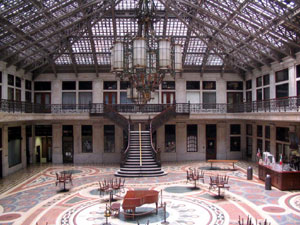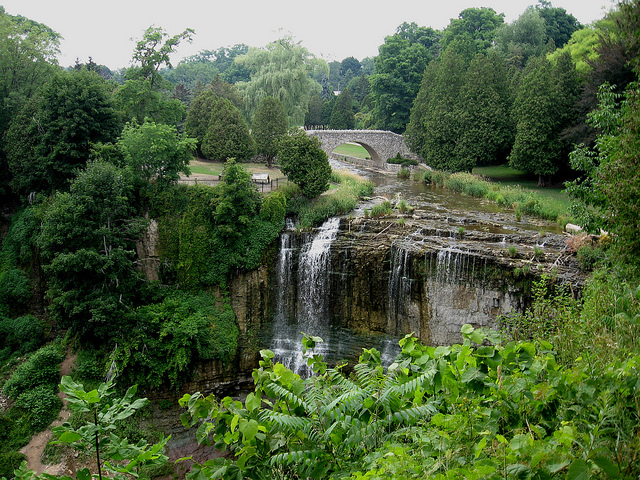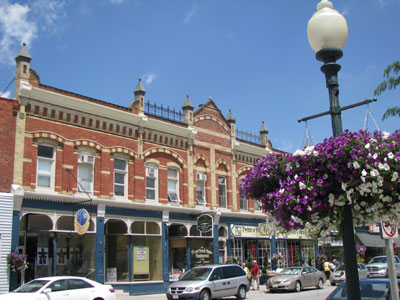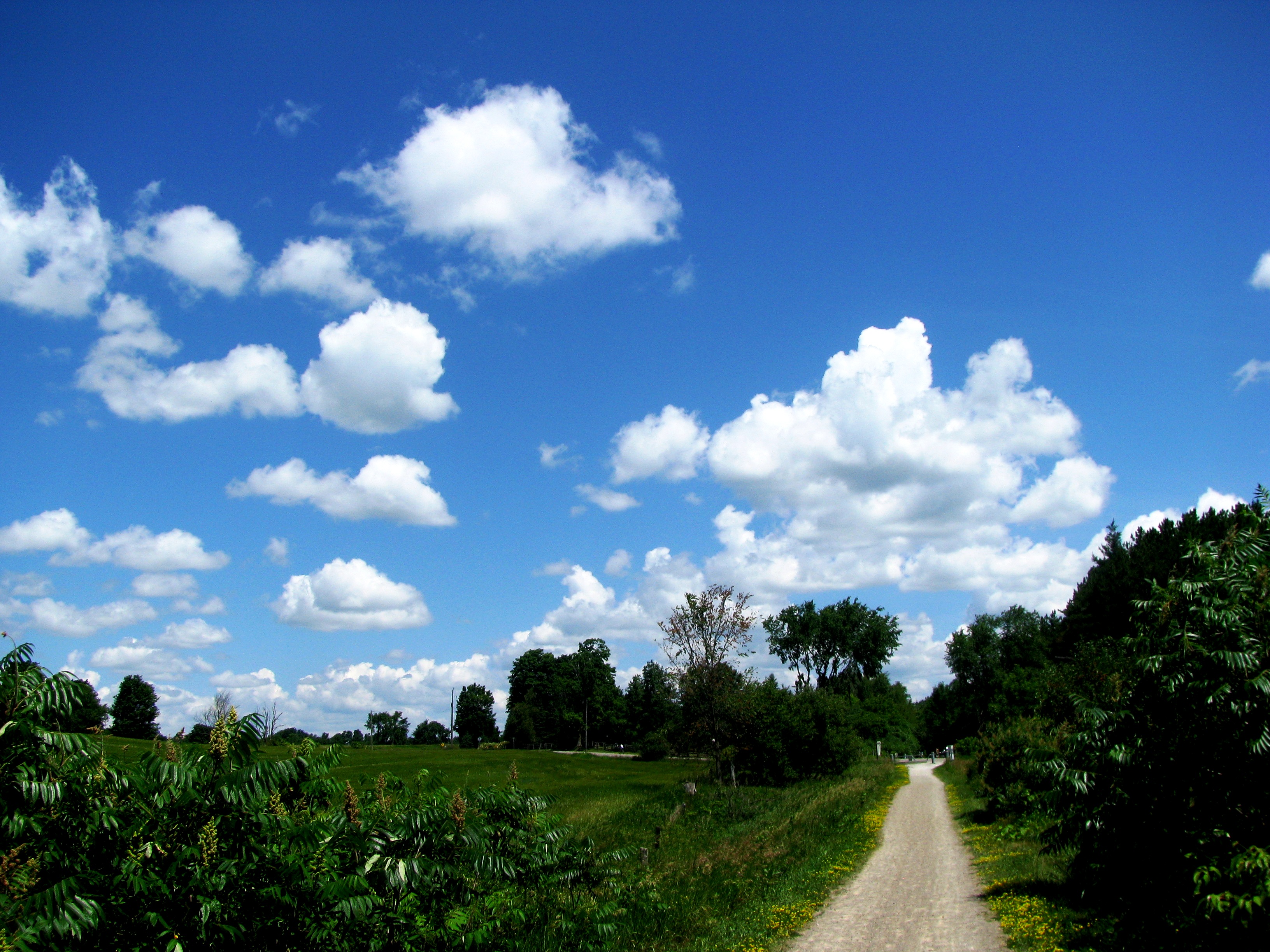My theory is a real traveler is able to discover interesting things even in the most unlikely of places. Well, Buffalo probably hasn’t made the “top travel destinations” list for a while, but I have been doing some research on it and I thought it’s high time to explore Buffalo, the closest American city to Toronto, just south of Niagara Falls and right across the Fort Erie border.
So my fellow travel and architecture aficionado Shauna and I headed out early yesterday morning to make the 2 hour trek to Buffalo. We picked the Fort Erie border crossing and fortunately it wasn’t very busy at all. The border crossing was actually a reasonably pleasant experience as the border guards were in a really good mood and very friendly, a nice foreboding to a good day.
Approaching the city we immediately took a wrong turn and headed south on Highway 5 away from downtown. But we got to see Buffalo’s waterfront, which in this area includes a few rather unspectacular marinas and some old run-down industrial buildings. We turned ourselves around and headed back towards the downtown area. Because the tourist information office was closed on Sunday we figured, we’d stop in at the Hampton Inn & Suites Hotel to pick up some tourist brochures and city maps. Another pleasant experience: The lady at the front counter was extremely helpful, provided us with several brochures and a printout of how to get to 2 of the most important architectural heritage sites in Buffalo: Frank Lloyd Wright’s Martin House and his other important Buffalo work, Graycliff Mansion.
Having parked the car on Delaware Avenue at about 10:30 am, the one thing that struck us immediately was how empty the streets were. There was virtually no pedestrian traffic at all and very few vehicles passing by. We figured it must be too early for people to be out, and we headed off into a restaurant called “Flappy’s” to strengthen ourselves for the day with a filling brunch. We booked our tour at the Martin House for 2 pm, so after breakfast we had about 2 hours to do a walking tour of downtown.

Buffalo’s City Hall
As we came out of the restaurant we noticed the city had gotten a bit livelier, but not by much. We parked our car close to Niagara Square and started our exploration on foot. First on the agenda was the Buffalo City Hall, a monumental Art Deco skyscraper completed in 1931, built of orange-hued sandstone with intricate details and colourful ornamentation. An immensely impressive building. We examined all the facade details and friezes which display images related to agriculture.

The Guaranty Building
We did a little downtown circle and covered a few really interesting buildings. The red colour and detailed ornamentation of Louis Sullivan’s Guaranty Building really captured our imagination. We passed by St. Paul’s Cathedral and past the trolley tracks of Main Street we discovered the Elicott Square Building. The east entrance to the building was actually open so we went inside. This building was erected in 1896 according to a design by Daniel Burnham, one of Chicago’s most famous architects. This building is constructed around a large interior court covered by a glass block ceiling held up by ornamented steel girders. We commented on how similar this design was the one of Chicago’s most famous buildings, the “Rookery”, and it wasn’t until this morning that I realized that both buildings were created by the same architect.
 .
.
Courtyard in the Elicott Square Building
It’s an amazingly impressive building with gorgeous sweeping staircases and an intricate mosaic covering the entire courtyard. From the Ellicot Square Building we headed towards the Lafayette Hotel, a handsome red brick and white terra cotta French Renaissance-style building which was built in anticipation of the expected influx of visitors at the Pan-American Exposition in 1901. Due to financial difficulties, however, it was not opened until 1904. From there we checked out the General Electric Tower, a handsome white Terracotta-clad structure dating back to 1912.

The Electric Tower
The Electric Tower happens to be right beside another fascinating building: the Buffalo Savings Bank, a building manifesting Buffalo’s boom of the second half of the 19th century. In the late 1890s – the peak of Buffalo’s golden age – the bank held a competition for a grand new headquarters. The contest was won by Green & Wicks, Buffalo’s premier turn-of-the-century architectural firm. Their design projected stability, security, and aspiration.The building’s signature feature is the gold-leafed dome.

The Buffalo Savings Bank
After the Buffalo Savings Bank we explored the Genesee Building which today is the Hyatt Regency Hotel. Just as we finished exploring that building the heavens opened up and there was a torrential downpour so we sat down in front of the Hyatt and took in the street scene. We were facing Main Street, the street that is now a pedestrian zone and accommodates Buffalo’s light rail rapid transit line. One thing we consistently noticed in Buffalo was the absence of street-level stores and restaurants. In the downtown core, as a matter of fact, most of the modernist office and government buildings did not have any street level retail at all. A lot of the modern administrative buildings in Buffalo have a rather austere and non-welcoming feeling and some of the newer buildings dating back to the 50s and later have an almost penitentiary feeling to them. The resulting scarcity of street-level store fronts combined with the utter lack of pedestrians (certainly on the weekend) really gives downtown Buffalo a rather eerie deserted feel, and the absence of people downtown was our most striking impression of Buffalo. Judging from the classically styled street lamps with blooming planters, however, the city appears to have been working on beautifying the downtown core.

The Lafayette Hotel
We started heading back to the car and passed by the Statler Hotel, which isn’t really a hotel any more, but apparently a building full of lawyer’s offices. We had a look inside the impressive lobby which features French chandeliers from the early 20th century. I took a couple of pictures, but the security guard stopped me, telling me no photography was allowed. We had a really interesting chat after this and he commented on long-standing economic problems of Buffalo and how in his opinion, the current mayor had only made things worse. One example of the city’s economic problems is that the stately ballroom of the Statler Hotel had only been recently reopened after having been closed down since 1957. Furthermore, a previous owner of the building had tried to create a food court in the basement and had opened up the main floor, but ran out of money before the food court could be built. So now you have a rather obtrusive opening on the ground floor with a view into an empty basement without stores or food outlets. Our local contact also commented on the reasons why downtown Buffalo was so devoid of people, and he said that all the locals did their shopping at the suburban malls and big warehouse stories. That, combined with the economic woes of the city, has apparently created a flight into the suburbs that has left the city’s core rather lifeless on the weekend.
It was really quite sad to see that a city like Buffalo, which has such a great number of outstanding architectural heritage sites, had virtually no street life, retail or shopping opportunities in the downtown core. A lot of stores were boarded up and the few stores that were there were closed down tight on the weekend.

The Martin House in Buffalo
Well, we had to move on to our tour of another architectural jewel, Frank Lloyd Wright’s Martin House. Darwin Martin was a high-ranking executive with the Larkin Soap Company and his brother-in-law had encouraged Darwin to seek out Wright’s work in Oak Park, a suburb of Chicago. After familiarizing himself with Wright’s work, he brought him to Buffalo in November 1902 to build a house for his sister, the Barton House, with a size of about 4000 feet, and then to build his main house, a 15,000 square foot Prairie Style home, characterized by Wright’s rigorous and consistent use of cruciform plans, piers and cantilevers, and other prairie house principles. After many years of neglect, the Martin house is now under renovation to restore it back to its original early 1900’s authentic splendour.
Right now the building is empty and a few large photographs illustrate the former decor and furnishings. It’s very visible that this building has been neglected for a long time and the Martin House Restoration Corporation is working very hard to restore it back to its authentic 1907 characteristics, even to the degree of rebuilding the pergola and the coach house that were demolished by a previous owner. The tour lasted about 90 minutes and was provided by a very passionate docent and all the volunteer staff in the gift shop and the chaperone were very helpful. We even received a glass of water in the 60s style kitchen of the Martin House which will be torn out and replaced by more authentic furnishings as the renovation continues.
After the humid heat inside the Martin and Barton Houses we were glad to get outside to cool down. We drove through the Park Side East Historic District surrounding Delaware Park, a creation of the famous landscape designer Frederick Law Olmstead, who also designed Central Park. The area around Delaware Park and the Forest Lawn Cemetery is a beautiful part of the city with gorgeous mansions and manicured lawns, and this beauty is most visible on Millionaires’ Row along Delaware Avenue. There was much more traffic and street life in this part of Buffalo, the atmosphere was pleasant and the residential areas impressive.

On the waterfront in Lewiston
We headed over closer to the Niagara River and drove along the Seaway Trail, crossed Grand Island and continued on the outskirts of Niagara Falls, NY, right along the Niagara River towards Lewiston. The drive north of Niagara Falls to Fort Niagara State Park on Lake Ontario is gorgeous, with beautiful old homes overlooking the Niagara River, huge trees overhanging the 2-lane country road, with well-kept properties on either side of the road. We stopped for a snack just outside the very quaint town of Lewiston, in a place called the Silo, which is right next to the river, overlooking a launch area for the high-speed boats that whisk visitors into the rapids of the Niagara Gorge. We had a lovely greasy lunch outside, enjoying the breeze (hey, you don’t have to eat healthy every day) and then continued our drive all the way to Fort Niagara State Park, admiring the villas and estates.
We had chosen to cross the border at the Queenston-Lewiston Bridge, but construction work had caused confusing detours and a local New York State father and son team stopped their car when they saw us by the road, staring at the map, trying to figure out how to get to the border crossing. They rolled down the window and said they’d guide us to the bridge, which they did. We followed them for about 10 minutes through the maze of detour signs until we found the bridge and headed back over to Canada. Both of us were very impressed with the friendliness and helpfulness of the locals.

Along the Port Dalhousie pier
Back on the Canadian side we drove along the Niagara Parkway and stopped in the beautiful little village of Niagara-on-the-Lake. NOTL calls itself the “prettiest village in Ontario”, and they might just be right. The village is home to beautifully maintained Victorian homes, overflowing flower baskets, souvenir shops, cafes, bed and breakfasts, as well as the famous Shaw Festival, and for many Ontarians it is a favourite destination for a quick weekend getaway.
From Niagara-on-the-Lake we headed through vineyards and orchards to St. Catharines, and to its Port Dalhousie waterfront entertainment area, not forgetting to stop by a road-side fruit stall to buy ripe red cherries and nuclear-size apricots fresh from the tree. About 20 minutes from NOTL, Port Dalhousie harbours a marina and a long pier and numerous outdoor patio restaurants, ice cream parlors, souvenir shops and other entertainment. Hundreds of people were parading along the pier, couples, parents with children, dog owners, retired folks and a very interesting young lady with red hair, whose friend had given her poodle a matching-colour hairdo with the leftover hair dye.

Red (pink) hair, anyone?
The atmosphere in Port Dalhousie was almost like in a Californian seafront resort town with rollerbladers, walkers, beach volleyball players, boaters and relaxed pedestrians taking a stroll through the village and on the pier. I did not even feel like I was in Ontario. The sun was starting to set and lake was laid out in front of us like an ocean, with no shoreline visible on the other side. It was a beautiful hot evening and I felt like I wanted to spend a whole week in this happening spot. But no such luck, we had to get back to Toronto after our exciting girls-only excursion to Buffalo and the Niagara Peninsula.
We got to explore some fabulous architectural gems, connected with the legacy of Frank Lloyd Wright, had a lovely greasy lunch right next to the Niagara River, enjoyed the hospitality and the helpfulness of the local New York State residents, and back on home territory, we hopped along the Lake Ontario shoreline to enjoy fresh fruits, frozen yogurt and an amazingly relaxing late afternoon by the waterfront. It doesn’t get much better than that…..




